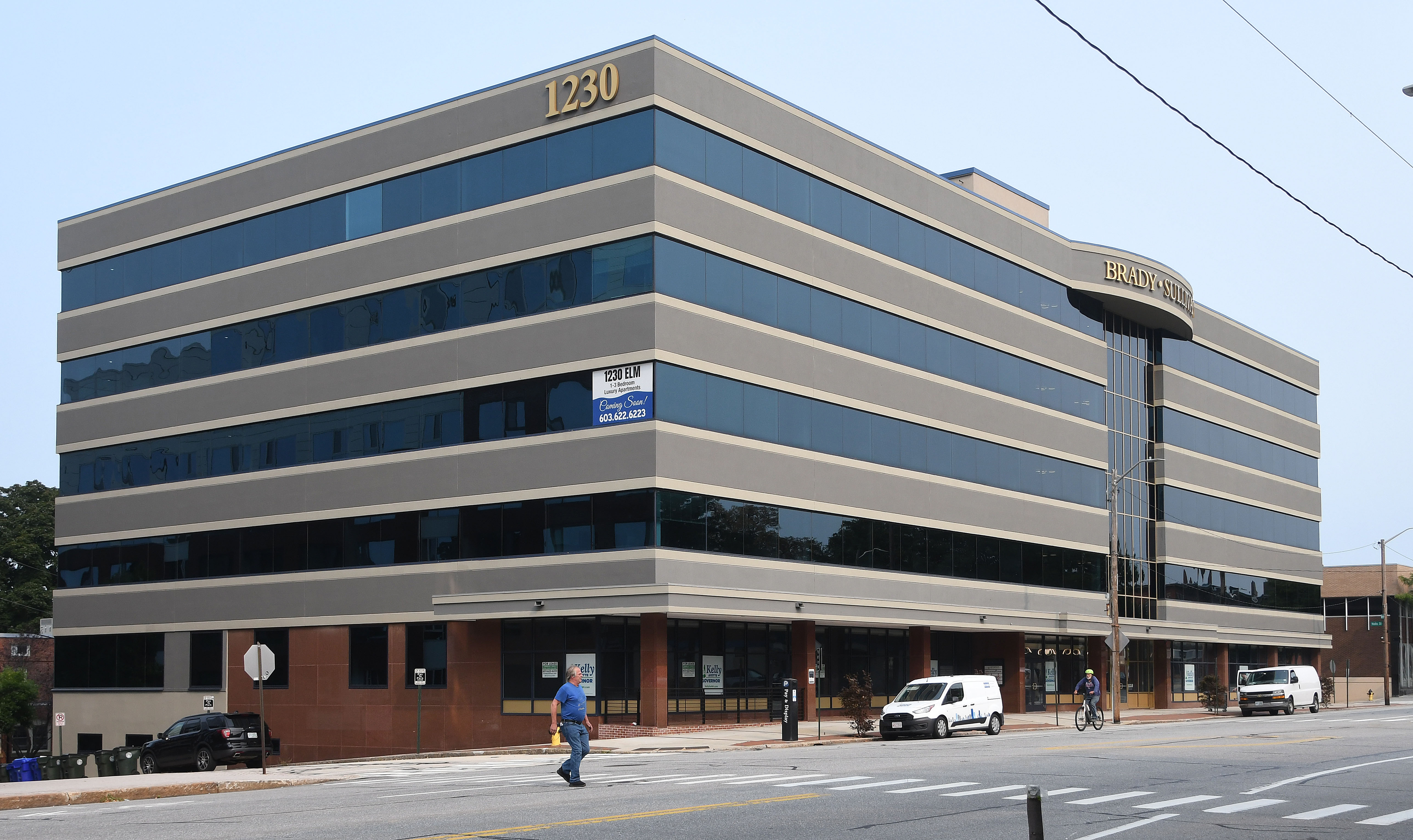
The Brady Sullivan building at 1230 Elm St. in Manchester is being converted into luxury apartments. (Photo by Jodie Andruskevich)

Office space vacancy in New Hampshire has been on the increase for the last several years. At the end of the second quarter in June, the vacancy rate stood at 13.5%, an increase of 2.4% over the same time frame in 2023, according to a new report from Colliers New Hampshire.
Which begs the question: Can that vacant space be turned into much needed housing?
The answer is a qualified yes, because while the proposition is certainly possible, actually doing it is complicated, according to Tracy Kozak, a Portsmouth architect who’s been busy with commercial-to-housing proposals.
Per Colliers, a commercial real estate broker with offices in Manchester and Portsmouth, New Hampshire has a total of about 23.6 million square feet of office space. A vacancy rate of 13.5% means some 3.2 million square feet currently stands empty.
“Over the past five years, Class A vacancy rate has surged, rising by 13.1%, with the most significant increase of 8.5% occurring in the last year,” Colliers analyst Kristie Russell wrote in her Q2 2024 report. “Companies have closed or downsized their NH locations, notably affecting the Dover, Portsmouth and Salem submarkets.”
Zoning limitations
A significant boost in the vacancy rate occurred with Liberty Mutual’s decision to close its 575,800-squarefoot Dover office at the end of 2023, according to Russell.
New Hampshire has a dearth of residential housing, be it apartments to rent or condos/homes to own. According to the 2023 New Hampshire Statewide Housing Needs Assessment, the state needs an additional 23,670 units to meet current needs, and nearly 90,000 more by 2040.
One example of how the issue is being addressed is in Manchester at 1138 Elm Street, where developer Andrew Winslow is converting a commercial building once owned by a debt collection company into a mixed use of 36 apartments and retail/storefront.
“I think it’s a viable model,” said Winslow when asked about the general notion of taking unused commercial space and converting it into housing, especially with workforce housing as an emphasis.
Kozak, principal at ARCove Architects, agrees. Earlier this year, Kozak was a panelist on the topic of converting commercial space to housing at an event sponsored by New Hampshire Housing.
“We are seeing a lot of clients come to us asking to change office to residential, but it’s a struggle,” said Kozak. She said her firm is working on proposals to convert a total of about 100,000 square feet of commercial space into housing in the Seacoast area.
Chief among the struggles, she said, is zoning. “Different uses have different requirements and restrictions,” she said. “So, depending on how it’s zoned, we are limited as to what type of housing it might be.”
There is interest in redevelopment of offices into both apartments and condominiums/townhouses, according to Kozak.
One of the first obstacles, she noted, is just where an office building might be located. If it’s in a commercial zone, then the municipality would have to rezone that district to a more general mixed use in order to accommodate the housing, whether it’s apartments to rent or condos to buy.
Within the zoning are requirements for parking, which can often complicate a conversion, she said. As well, fire codes for residential buildings versus commercial buildings are often more stringent, according to Kozak, citing the travel distance to exits as an example.
“If there is a change of use for an existing building, it must be brought up to current codes, and the building codes for residential use are much stricter than business use, because people are sleeping there,” said Kozak, who opened ARCove in January 2022 with the mission of designing commercial and residential uses that emphasize high-performance, sustainable design, adaptive reuse and historic preservation.
“There’s a higher level of risk, so fire ratings and travel distances between exits — all these things are a little bit different,” she added. “Developers will certainly have extra costs to put in all the fire separations and that would require for egress and in New Hampshire, we have to fire sprinkler multi-family, whereas some business uses in certain conditions might not have needed that. So, the cost can add up quickly.”
Economics of building housing
Winslow’s Elm Street project is a conversion of the office building that housed Lamont, Hanley & Associates, Inc., which relocated to 186 Granite Street in Manchester in the summer of 2023. It comprises 16,555 square feet over four stories.
“It’ll come back to the studs,” said Winslow. “It will need all new electrical, plumbing, HVAC. We’ve got to pull out the staircases and rebuild new staircases that meet code; we’ll have fire suppression that meets code. It’s a complete redo of the shell of the building, leaving the exterior pretty much as is. There’s a lot of history to that building, and it’s got an important look and feel to that part of the downtown.”
The ground floor will have opportunities for retail storefront, while the upper three floors will have 36 one- and two-bedroom apartments. Fourteen of the units will be workforce/subsidized housing, the rest will rent at market rates.
With City of Manchester zoning variances approved in July, Winslow, as Elm Rentals LLC, is working on remaining permitting and property tax relief approval. He hopes the completed project will come online sometime in 2025.
His past projects — renovating vacant, fire-damaged residential structures on Lake Avenue and Dutton Street — proved to him the need for voucher housing and the type of conversion he is doing on Elm Street.
“Dutton street really proved it out. We got our certificate of occupancy at the end of October, like October 30 or November 1, eight out of nine units were occupied with people living there, and the last one on December 1. And so that’s how much pent-up demand there is,” he said.
For Winslow, while zoning was a challenge, equally challenging are the economics of building housing that includes voucher units.
“Everything surrounding this building is market rate, and so they’re renting one-bedroom units for $2,000 to $2,300, two bedrooms are going for $2,200 up to $3,000. It’s one thing to have a budget that’s feasible at those rents, but when we’re looking at rents that are $1,500 or $1,600 a unit, it’s much more of a challenge because we need to do all of the same things,” he said, noting all the work required to bring the Elm Street building up to code for residential.
“Construction costs are up. Interest rates are high. So, for us, that’s really a challenge. How do you build something at a cost that enables projects to still be feasible, and to offer rents that people can afford to pay,” he added.

The commercial building at 1138 Elm St. in Manchester is being redeveloped by Andrew Winslow into a mixed use of 36 apartments and retail/storefront space. (Photo by Jodie Andruskevich)
Collaborating for a solution
Working with Winslow on this project is Craig St. Pierre, who as a Realtor and property manager with Choice Realty, has extensive experience in managing and creating workforce subsidized housing.
He and Winslow agree that collaboration with New Hampshire Housing and the housing department in Manchester has been key in conversions as they seek to create properties for, as St. Pierre described, “the people getting left behind.”
“it’s really a collaboration with a number of housing agencies to find what they need and to create a product and fill the gaps that aren’t being serviced,” he said.
He did his own project two years ago converting what were doctors’ offices at 35 High St., Manchester, into five workforce/voucher units.
“The only real opportunity to create what is needed comes in these blank canvases of other underutilized buildings,” said St. Pierre. “And it’s socially responsible at the same time. Andy and I both believe very strongly that we will never displace a building to create housing for other people. So, when we can find a building that’s entirely empty, we’re able to create this without causing harm to other families.”
Colliers’ Russell observed the office space situation here midyear “is in an interesting position,” influenced by the residential conversions.
“Although the vacancy rate has been on the rise over the last two years, some office users are having difficulty securing space that fits their needs, especially in certain submarkets. Some Class A markets, as well as tenants seeking small blocks of space, are particularly affected,” said Russell.
“The impact of office-to-residential conversions has influenced all office categories in some submarkets, lowering vacancy rates and contributing to rising asking rates,” she added.
As an example, she cited the sale of the Wellington Trade Center at 25-27 Lowell Street in Manchester to North Street Properties for $3.15 million in May.
“This five-story building has been vacant for some time and will undergo major renovations to be converted to a 76-unit apartment building, thus removing it from the office category and reducing the vacancy rate in the submarket,” she said. “This reflects an ongoing trend in downtown Manchester, where vacant office buildings are being repurposed for residential use.”
Officials in the City of Dover said they want to be “involved” in whatever redevelopment occurs at the former Liberty Mutual campus, which has been on the market since September of last year. They cite what was done at Pointe Place off Dover Point Road, a walkable neighborhood mix of single-family and townhouses, as well as shopping, places to eat and an assisted living center.
“It is a carefully planned development, a walkable area,” Dover Deputy City Manager Chris Parker said to Foster’s Daily Democrat. “The Liberty Mutual properties can offer the same type of careful planning that benefits everyone — them, the city and the people who end up there.”
Looking forward
Meanwhile, the industrial/warehouse sector of the commercial real estate market in the state “is returning to a healthier balance of supply and demand,” Russell said in a separate Q2 2024 report.
“In the last couple of years, the market has heavily favored landlords due to limited supply and high demand.
Now the market is trending towards a healthier level, or more balanced, as rising vacancy rates are leading to more supply,” Russell added.
The overall vacancy rate at the end of Q2 for manufacturing, flex and warehouse is 5.9%, compared to 2.9% for the same time last year. As more space has opened up, Russell noted that the asking price for the space has decreased by 1% in the quarter-over-quarter comparison.
Russell said in her report that industrial construction surged after COVID-19, with approximately 3.1 million square feet completed over the last five years. The majority of the development was in the warehouse/distribution category, accounting for 64.5% of the total space.
Looking ahead, she noted there is an additional 6.5 million square feet either proposed or under construction across the state; these projects range from new developments by major developers to expansions by existing businesses.